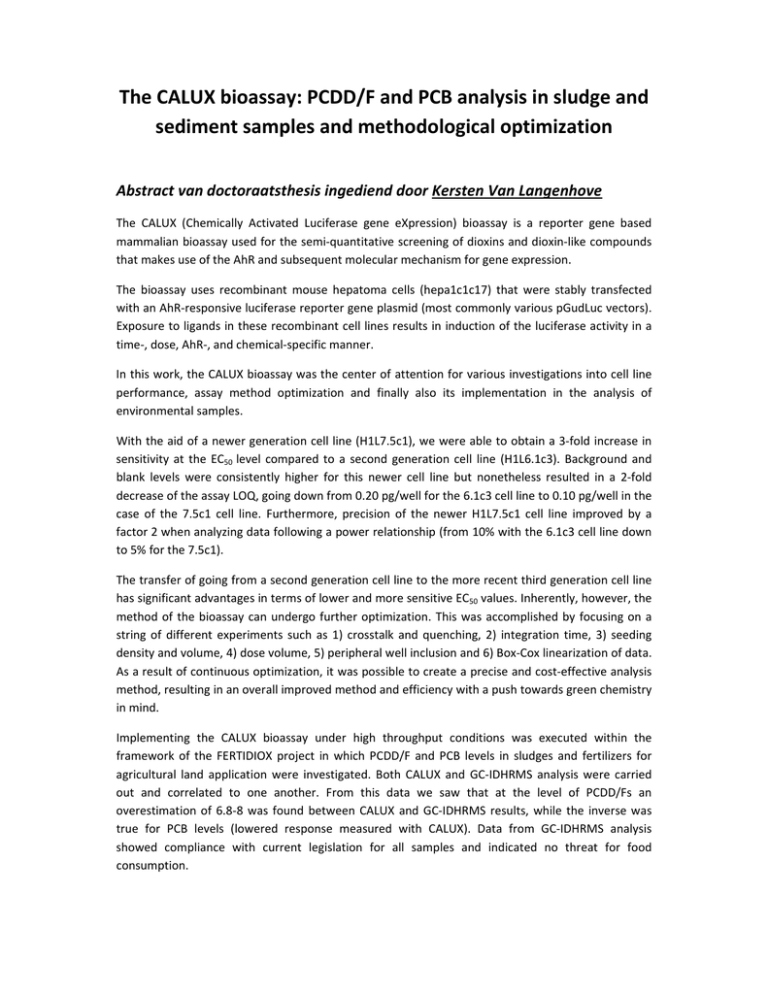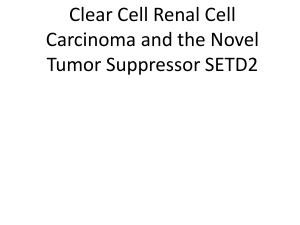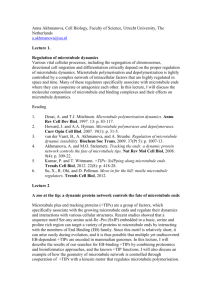The CALUX bioassay: PCDD/F and PCB analysis in sludge and
advertisement

The CALUX bioassay: PCDD/F and PCB analysis in sludge and sediment samples and methodological optimization Abstract van doctoraatsthesis ingediend door Kersten Van Langenhove The CALUX (Chemically Activated Luciferase gene eXpression) bioassay is a reporter gene based mammalian bioassay used for the semi‐quantitative screening of dioxins and dioxin‐like compounds that makes use of the AhR and subsequent molecular mechanism for gene expression. The bioassay uses recombinant mouse hepatoma cells (hepa1c1c17) that were stably transfected with an AhR‐responsive luciferase reporter gene plasmid (most commonly various pGudLuc vectors). Exposure to ligands in these recombinant cell lines results in induction of the luciferase activity in a time‐, dose, AhR‐, and chemical‐specific manner. In this work, the CALUX bioassay was the center of attention for various investigations into cell line performance, assay method optimization and finally also its implementation in the analysis of environmental samples. With the aid of a newer generation cell line (H1L7.5c1), we were able to obtain a 3‐fold increase in sensitivity at the EC50 level compared to a second generation cell line (H1L6.1c3). Background and blank levels were consistently higher for this newer cell line but nonetheless resulted in a 2‐fold decrease of the assay LOQ, going down from 0.20 pg/well for the 6.1c3 cell line to 0.10 pg/well in the case of the 7.5c1 cell line. Furthermore, precision of the newer H1L7.5c1 cell line improved by a factor 2 when analyzing data following a power relationship (from 10% with the 6.1c3 cell line down to 5% for the 7.5c1). The transfer of going from a second generation cell line to the more recent third generation cell line has significant advantages in terms of lower and more sensitive EC50 values. Inherently, however, the method of the bioassay can undergo further optimization. This was accomplished by focusing on a string of different experiments such as 1) crosstalk and quenching, 2) integration time, 3) seeding density and volume, 4) dose volume, 5) peripheral well inclusion and 6) Box‐Cox linearization of data. As a result of continuous optimization, it was possible to create a precise and cost‐effective analysis method, resulting in an overall improved method and efficiency with a push towards green chemistry in mind. Implementing the CALUX bioassay under high throughput conditions was executed within the framework of the FERTIDIOX project in which PCDD/F and PCB levels in sludges and fertilizers for agricultural land application were investigated. Both CALUX and GC‐IDHRMS analysis were carried out and correlated to one another. From this data we saw that at the level of PCDD/Fs an overestimation of 6.8‐8 was found between CALUX and GC‐IDHRMS results, while the inverse was true for PCB levels (lowered response measured with CALUX). Data from GC‐IDHRMS analysis showed compliance with current legislation for all samples and indicated no threat for food consumption. Het CALUX bioassay: PCDD/F en PCB analyses in sludge en sediment stalen en optimalizatie van de methode Abstract van doctoraatsthesis ingediend door Kersten Van Langenhove Het CALUX (Chemically Activated Luciferase gene eXpression) bioassay is een reportergen gebaseerd bioassay dat toegepast wordt in de semi‐quantitatieve screening van dioxines en dioxine‐achtige stoffen die gebruik maken van de AhR en het daarbij horende moleculaire mechanisme voor genexpressie. Het bioassay maakt gebruik van recombinante muis hepatoma cellen (hepa1c1c7) die stabiel werden getransfecteerd met een luciferase reportergen plasmide dat een respons stimuleert ten gevolge van AhR binding (pGudLuc vectors). Blootstelling naar liganden in deze recombinante cellijnen resulteert in inductie van luciferase activiteit op een tijds‐, dosis‐, AhR‐, en chemisch specifieke manier. In dit werk is het CALUX bioassay het aandachts‐ en uitgaanspunt voor verschillende experimenten die betrekking hebben tot performantie van verschillende cellijnen, optimalisatie van de methode alsook de implementatie van deze techniek bij de analyse van milieustalen. Met behulp van een nieuwere generatie cellijn (H1L7.5c1) was het mogelijk om een verbetering in de sensitiviteit op het EC50‐niveau (met een factor 3) te bekomen in vergelijking met een 2de generatie cellijn (H1L6.1c3). Basale en blanco niveaus waren consistent hoger in de nieuwere cellijn maar desalniettemin resulteerde dit in een verlaging van de bioassay LOQ met een factor 2: van 0.20pg/well (H1L6.1c3) naar 0.10pg/well. Tenslotte was er ook een verbetering merkbaar in de precisie van de methode die van 10% zakte naar 5% (na het experimenteel berekenen van de power regressie). Bij het overstappen van een 2de naar een 3de generatie cellijn was het grootste voordeel de 3x lagere EC50 waardoor gevoeliger gemeten kon worden. Uiteraard kon er op het vlak van de methode ook nog vooruitgang geboekt worden. Door het optimalizeren van 1) crosstalk en quenching, 2) integratietijd, 3) cell densiteit en volume, 4) dosis volume, 5) rand‐effecten en 6) Box‐Cox linearizatie van data kon de methode performanter worden. Ten gevolge van deze continue optimalizatie was het mogelijk om een precieze en kosten‐efficiente methode te ontwikkelen. Het toepassen van de CALUX techniek in routine analyse werd uitgevoerd binnen het FERTIDIOX project waarbij PCDD/F en PCB niveaus in sludges en meststoffen (bestemd voor agricultuur doeleinden binnen België) werden nagegaan. Zowel CALUX als GC‐IDHRMS analyses werden uitgevoerd en met elkaar gecorreleerd. Gebaseerd op deze data zagen we een overschatting van de PCDD/F niveaus van het CALUX bioassay ten opzichte van de GC‐IDHRMS techniek. Het omgekeerde was waar voor de PCB fractie waarbij een lagere respons werd waargenomen met de CALUX techniek. Data van GC‐IDHRMS analyses confirmeerde dat PCDD/F en PCB niveaus in regel waren met de wetgeving en dat er geen indicatie was naar potentiële bedreigingen voor de voedselketen.

